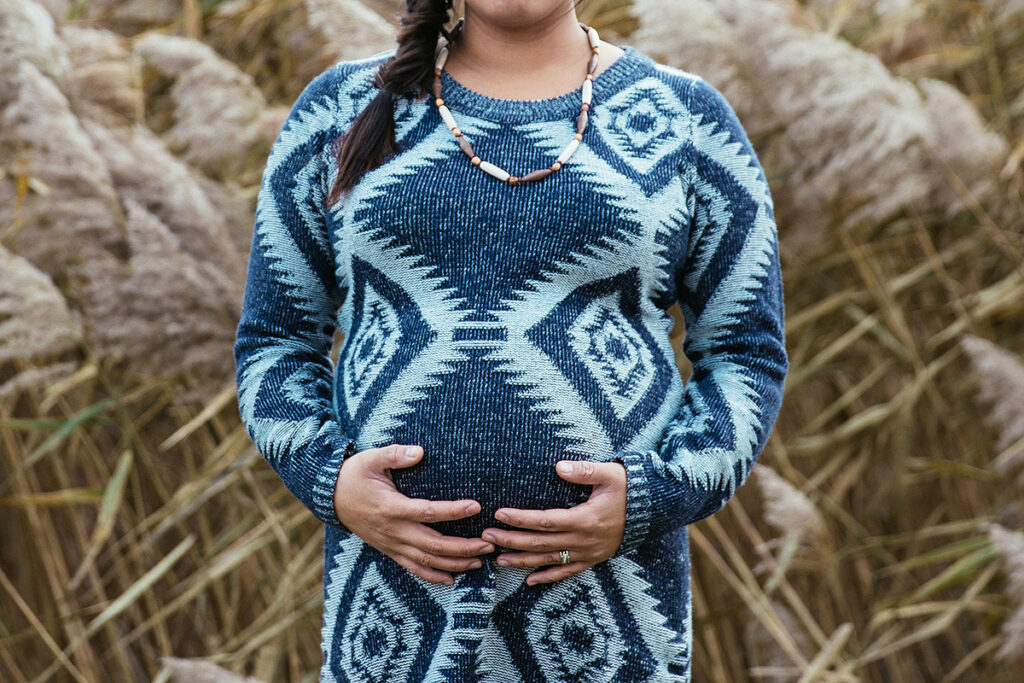In mid-March 2020, a 35-year-old woman at 22 weeks of pregnancy went to the clinic with symptoms of COVID-19. Her husband was in contact with a person with a laboratory-confirmed COVID-19 with associated symptoms. Ten days before hospitalization, the woman had a fever and cough. The symptoms have dramatically worsened over the four days before admission – high fever, malaise, dry cough, diffuse myalgia, anorexia, nausea and diarrhea.
On the morning of the treatment, the patient woke up from vaginal bleeding and abdominal pain. She did not have a fever. The breathing rate was 22 breaths per minute, and the oxygen saturation was 99% in the room air. However, the patient’s pulse is 110 beats per minute, and blood pressure is increased to 150/100 mm Hg.
Medical examination showed the presence of dark blood in the vaginal arch without dilating the cervix. A smear from the nasopharynx detected SARS-CoV-2 RNA.
The woman had a history of psoriasis with no current symptoms. Also, she had a previous pregnancy complicated by gestational hypertension. Hypertension passed with childbirth.
Hypertension is one of the signs of preeclampsia, a complication of the second half of pregnancy. During preeclampsia, vascular wall permeability increases, blood pressure increases, protein loss occurs in the urine – proteinuria, edema, and multiple organ failure occur.
The patient’s blood pressure was stable during the current pregnancy, and preeclampsia was not expected.
The patient was admitted to the maternity ward. Chest x-rays showed turbidity in the left lung. Transabdominal ultrasound revealed an active fetus weighing about 485 grams, a standard volume of amniotic fluid, and a retroplacental clot in the fundal part of the placenta. This clot indicated a possible placental abruption. Laboratory tests revealed elevated hepatic transaminases, deep thrombocytopenia, and increased protein levels in the urine – an indicator of preeclampsia. The patient also showed signs of extensive intravascular coagulation: prolonged partial thromboplastin time and decreased fibrinogen. A blood smear found atypical lymphocytes indicating viral infection and severe thrombocytopenia.
The patient was resuscitated using 4 units of cryoprecipitate, 4 pools of packed platelets, 2 grams of tranexamic acid(TXA), 5 grams of fibrinogen concentrate and 2 units of freshly frozen plasma, which reduce the coagulopathy. However, thrombocytopenia and high blood pressure remained.
The combination of hypertension, proteinuria, elevated transaminases and low platelet count confirmed the diagnosis of severe preeclampsia, which is treated by delivery.
The patient decided to terminate the pregnancy in order to reduce the risk of maternal diseases and death. Termination of pregnancy was performed under General endotracheal anesthesia by dilation and evacuation (D&E). During the operation, the retroplacental clot shown earlier by ultrasound was detected.
On the 1st day after the operation, the patient developed lymphopenia. Soon the markers of coagulation improved, and on the 3rd day after the operation, the patient was discharged for self-isolation. Blood pressure monitoring continued at home. On the 4th day, a visit to the emergency department was required to determine the dose of antihypertensive drugs. The patient agreed to a pathological examination and the transfer of tissues for research.
Hypertension and coagulopathy in pregnant women with COVID-19
Hypertensive disorders complicate 2-8% of pregnancies and rarely occur in the second trimester. Women with COVID-19 sometimes also experience hypertensive disorders. At the same time, non-pregnant patients with COVID – 19 have changed the level of liver enzymes, and impaired blood clotting-coagulopathy is observed. The same abnormalities are present in severe preeclampsia – one of the hypertensive disorders in pregnancy. Preeclampsia has increased levels of liver enzymes, reduced platelet count, proteinuria and high blood pressure.
Microbiological examination
Quantitative PCR (qRT-PCR) showed that the placenta (3 × 10 7 copies of the virus/mg) and the umbilical cord (2 × 10 3 copies of the virus/mg) were infected with SARS–CoV-2. Heart and lungs tissues of the fetus were consistent with the standards of the RNA, and the infected person was not. After the operation, the mother was also tested for SARS-CoV-2. Smears from the mouth and nose were negative, but saliva and urine were still positive. The virus from the placenta was not genetically different from SARS-CoV-2, previously found in the United States, Europe, and Australia. The SARS-CoV-2 genome from the placenta did not contain any unique amino acid substitutions compared to other sequenced SARS-CoV-2.
Serological testing
Levels of IgG and IgM antibodies to SARS-CoV-2 in the patient were among the highest among 56 patients with COVID-19 admitted to Yale hospital in new haven. The antibody titers were 1: 1600 for IgM and 1: 25,600 for IgG.
Pathology
A macroscopic examination revealed a blood clot associated with a focal placental infarction. This finding confirmed the clinical diagnosis of placental abruption. Histological examination of the placenta revealed the presence of fibrin deposits (fibrin – protein, the result of blood clotting) and inflammatory infiltrate consisting of macrophages and T-lymphocytes. It indicates inflammation of the intervillous spaces of the placenta called the intervillositis. There is no dark pigment in the interstitial space. No inflammatory cell infiltration of the vascular wall was observed in maternal vessels. The organs of the fetus are externally and microscopically unremarkable. SARS-CoV-2 is localized mainly in syncytiotrophoblastic cells of the placenta – a layer of cells that provide absorption of nutrients from the mother’s blood and produce enzymes for the introduction of chorionic villi into the uterus.
Electron microscopy
Electron microscopic analysis of the placenta showed a well-preserved ultrastructure of the placenta. Analysis of the placental region adjacent to the umbilical cord revealed SARS–CoV-2 viral particles in the cytosol of placental cells.
Fibrin deposits and macrophage infiltration in the placenta
The patient previously had gestational hypertension. That increased the risk of preeclampsia during the current pregnancy. Preeclampsia, placental abruption, and disseminated intravascular coagulopathy (DIC) are usually seen together in obstetric practice. Infection of the placenta with the SARS–CoV-2 virus shows that COVID-19 may have caused inflammation of the placenta, which led to early preeclampsia and deterioration of the mother’s condition.
Intervillusitis is characterized by fibrin deposits and the infiltration of mononuclear cells in the interstitial spaces. It is associated with a high rate of miscarriages, fetal growth retardation, and severe early preeclampsia. As a rule, intervillusitis has an autoimmune or idiopathic origin. Nevertheless, it can also be linked to infections: cytomegalovirus and malaria. Pregnant women with SARS also have fibrin deposition in the placenta.
A case of miscarriage in the second trimester of pregnancy on the background of SARS–CoV-2 was also described. The pregnant woman from the described case did not have preeclampsia, but there was an interstitial deposition of fibrin. It is not known whether COVID-19 provoked intervillusitis, but massive macrophage infiltration along with fibrin deposition was also observed in the lung tissue of patients with severe COVID-19. It increases the likelihood of immunopathology, which leads to the attraction and activation of macrophages in the tissues and causes tissue damage.
Coagulopathy in the coronavirus
Coagulopathy is observed in patients with COVID-19. It is associated with a poor prognosis. However, thrombocytopenia and fibrinogenopenia in the patient from the present study were not only associated with COVID-19. Both SARS-CoV-2 and hypertensive disorders reduce the activity of angiotensin-converting enzyme 2 (ACE2). It leads to an increase in tissue levels of angiotensin 2. Increased levels of angiotensin 2 contribute to the development of hypertensive complications, including preeclampsia in pregnant women with COVID-19. SARS-CoV-2 may reveal a predisposition to hypertensive disorders, and COVID-19 leads to placental pathology and severe patient condition.
Infection of the placenta with coronavirus
A microbiological study of the placenta showed that there are no amino acid differences in the SARS–CoV-2 genome sequenced from the placenta compared to other SARS–CoV-2 sequenced from around the world. It means that infestation through the placenta is not a unique feature of the coronavirus. Since the patient had high titers of antibodies to SARS-CoV-2, a possible mechanism of infection of the placenta is the antibody-dependent transport of substances through the cytoplasm from one pole of the cell to the other (transcytosis). The same mechanism applies to the fetal transmission of cytomegalovirus, Zika virus, and HIV.
SARS-CoV-2 is localized in placental syncytiotrophoblastic cells. It is the outer layer of multinucleated cells that cover the chorionic villi and contact the mother’s blood in the intra-dorsal space. Syncytiotrophoblasts form a cellular layer between the blood circulation of the mother and the fetus. They are involved in the transfer of protective antibodies through the placenta. Some viruses infect syncytiotrophoblasts, and the viral infection can be transmitted to fetal cells.
Acute placental infection with SARS-CoV-2 in the patient from the present study may have increased severe early preeclampsia. Identification of hypertensive disorders association with COVID-19 and diagnosis are crucial for patient care and pregnancy counselling during the coronavirus pandemic.



